#the getty address
Explore tagged Tumblr posts
Text
i think itis funny in the past when i would list my interests as if i post abt them i donot post abt the shit im into rly Mainly bc im not rly Into Into anything anymore i occasionally watch or read or play something but i dont do fandom stuff rly much.... just sometimes i get brainworms
#do i still list my interests somewhere i dont knowwww#i just stopped rly being into fandom a few years ago combination depression antipathy + bad experiences in fandom spaces#but idk. me listing my interests didnt rly accomplish anything for anyone bc it was just like anddd just so you know i was crazy abt this#video game for a rly long time it probably wont ever come up again but it might maybe one day. yk. ig its just sharing info Which is one#supposes the point of all of this but idk#its not that im cagey abt my interests except that one which i cant talk abt publically bc its a triple a game and im embarassed abt it. no#anything bad im just embarrassed . its not anything any of my oomfies have ever posted abt either so its just for me. and lamp . and when#the third game comes out i might post very very very vaguely abt it ......... possibly.#but ya its like. idk i think you guys have to find out abt my plague tale obsession on your own through lived experience. aka just me seein#like the word king and randomly collapsing to the floor and going KING HUGO 😭😭😭😭😭 oh god hugo guys oh god . please play plague tale#i wish i had finished that tw thing i started making but then i got too focused on the color palette and making it look nice and i stopped.#umm tw child death animal death The plague some gorey stuff theres some cult things in the second game ummm. yeah ..... its rly special to#me tho i love those games PLAY PLAGUE TALE!!! and if u need more indepth tws ill give them to you even if i have to replay both games to#refresh my memory... lamp wont play plaguetale with me (not their speed) so im all alone </3 but i miss it i might replay soon... i wish i#was in like discord servers so i could play it on call w ppl or something <- is in discord servers but is shy and Also i feel like playing#game on call is like a level like 2 friendship thing and i cant even do level 1 friendship things like i feel i need to at least be talking#regularly in a server b4 i like try to do Calls in the server esp for plague tale bc its like a 1p game so wed need a rapport to like have#shit to talk abt and etc ..... i could just infodump abt the game but again i feel doing that to like strangers/oomfies would b weird. ik i#come on here and talk abt whatever i want but its like you guys dont Have to read this and its not like a server where Yeah im not talking#to one person but im still like Oh well ive sent a message and its in the channel and everybody just has to look at it and whatever.#but on here i post i nobody cares and it just gets pushed down and its Fine bc its not like anybody has to feel obliged to respond#which is fine. you know.. i just hate being like a nuisance i hate . idk how to phrase. imposing myself on others ig.. which is dumb bc the#i turn around and whine abt how i have no friends and its like Maybe that is bc you donot talk to anyone bc yr scared they will be annoyed#with you and you dont leave the house and have no interests to bond with ppl and etc. but basically the difference is ive written all this#and you guys can just not read it or you can just read it and ignore it and its different. even tho i am like addressing you and i do have#like. weird parasocial thing with My followers or whatever where i talk directly to you YES YOU! reading this. IDKK im rambling so much i#dont know what im talking abt anymore. i proooooobably need to go to sleep im hungry tho but im not but i am. but i think my sleep is getti#off schedule again i had trouble sleeping yesterday too... ugh
3 notes
·
View notes
Text
I know this blog focuses on TIMs invading women’s sports and locker rooms but Saving Women’s Sports means more than that. Like calling out sexist bs when companies give men real clothes to compete in and women get basically underwear.
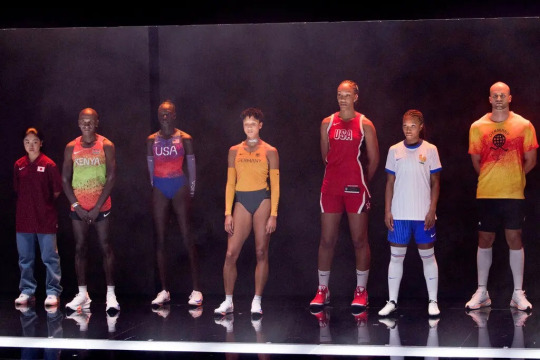
The Nike Air Innovation Summit in Paris on Thursday.Credit...Dominique Maitre/WWD, via Getty Images
By Vanessa Friedman April 12, 2024
Ever since the Norwegian women’s beach handball team turned the fact that they were required to wear teeny-tiny bikini bottoms for competition into a cause célèbre, a quiet revolution has been brewing throughout women’s sports. It’s one that questions received conventions about what female athletes do — or don’t — have to wear to perform at their very best.
It has touched women’s soccer (why white shorts?), gymnastics (why not a unitard rather than a leotard?), field hockey (why a low-cut tank top?) and many more, including running.
So it probably should not have come as a shock to Nike that when it offered a sneak peek of the Team U.S.A. track and field unies during a Nike Air event in Paris celebrating its Air technology on Thursday (which also included looks for other Olympic athletes, like Kenya’s track and field team, France’s basketball team and Korea’s break dancing delegation), they were met with some less-than-enthusiastic reactions.
See, the two uniforms Nike chose to single out on the mannequins included a men’s compression tank top and mid-thigh-length compression shorts and a woman’s bodysuit, cut notably high on the hip. It looked sort of like a sporty version of a 1980s workout leotard. As it was displayed, the bodysuit seemed as if it would demand some complicated intimate grooming.
Citius Mag, which focuses on running news, posted a photo of the uniforms on Instagram, and many of its followers were not amused.
“What man designed the woman’s cut?” wrote one.
“I hope U.S.A.T.F. is paying for the bikini waxes,” wrote another. So went most of the more than 1,900 comments.
The running comedian Laura Green posted an Instagram reel in which she pretended to be trying on the look (“We’re feeling pretty, um, breezy,” she said) and checking out the rest of the athlete’s kit bag, which turned out to include hair spray, lip gloss and a “hysterectomy kit,” so the women would not have to worry about periods.
When asked, Nike did not address the brouhaha directly, but according to John Hoke, the chief innovation officer, the woman’s bodysuit and the man’s shorts and top are only two of the options Nike will have for its Olympic runners. There are “nearly 50 unique pieces across men’s and women’s and a dozen competition styles fine-tuned for specific events,” Mr. Hoke said.
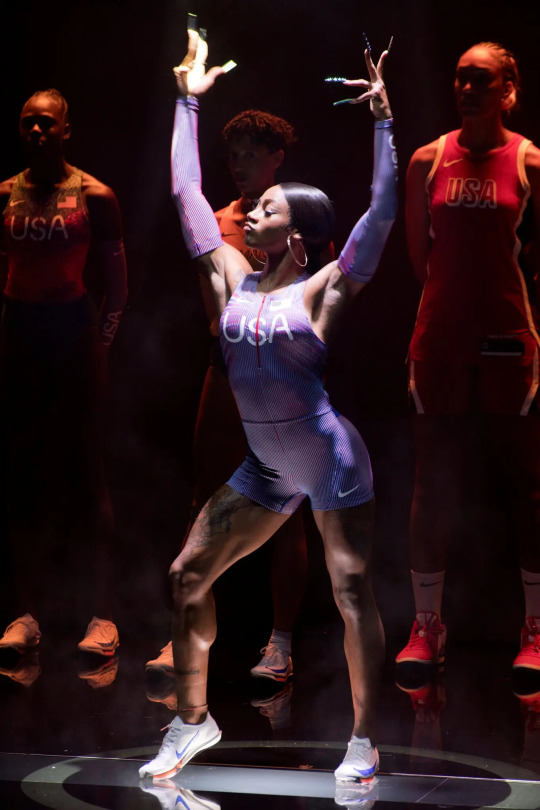
Sha’Carri Richardson
Women will be able to opt for compression shorts, a crop top or tank and a bodysuit with shorts rather than bikini bottoms. The full slate of looks was not on hand in Paris but more will be revealed next week at the U.S. Olympic Committee media summit in New York. The Paris reveal was meant to be a teaser.

Anna Cockrell.Credit...Dominique Maitre/WWD, via Getty Images
Mr. Hoke also pointed out that Nike consults with a large number of athletes at every stage of the uniform design. Its track and field roster includes Sha’Carri Richardson, who happened to be wearing the compression shorts during the Paris presentation, and Athing Mu. And there are certainly runners who like the high-cut brief. (The British Olympic sprinter Dina Asher-Smith, another Nike athlete, told The New York Times last summer that while she opts to run in briefs, she also leans toward a leotard style, rather than a two-piece.)
What Nike missed, however, was that in choosing those two looks as the primary preview for Team U.S.A., rather than, say, the matching shorts and tanks that will be also available, it shored up a longstanding inequity in sports — one that puts the body of a female athlete on display in a way it does not for the male athlete.
“Why are we presenting this sexualized outfit as the standard of excellence?” said Lauren Fleshman, a U.S. national champion distance runner and the author of “Good for a Girl.” “In part because we think that’s what nets us the most financial gain from sponsors or NIL opportunities, most of which are handed out by powerful men or people looking at it through a male gaze. But women are breaking records with ratings in sports where you don’t have to wear essentially a bathing suit to perform.”
The problem such imagery creates is twofold. When Nike chose to reveal the high-cut bodysuit as the first Olympics outfit, purposefully or not, the implication for anyone watching is that “this is what excellence looks like,” Ms. Fleshman said.
That perception filters down to young athletes and becomes the model girls think they have to adopt, often at a developmental stage when their relationships with their bodies are particularly fraught.
And more broadly, given the current political debate around adjudicating women’s bodies, it reinforces the idea that they are public property.
Still, Ms. Fleshman said, “I’m glad Nike put this image out as the crown jewel of Olympic Team design,” because it may act as the catalyst for another conversation that has been long overdue.
“If you showed this outfit to someone from the W.N.B.A. or women’s soccer, they would laugh in your face,” she said. “We shouldn’t have to normalize it for track and field anymore. Time’s up on that.”
#Nike#Team U.S.A.#Track and field#Nike Air#Paris#They couldn't even give women short shorts?#Nike has a chance for a do over
391 notes
·
View notes
Text
Jewish Columbia students were chased out of dorms, spat on, and pinned against walls: damning report
By Matthew Sedacca
Published Aug. 31, 2024, 3:44 p.m. ET
Jewish students at Columbia University were chased out of their dorms, received death threats, spat upon, stalked and pinned against walls, as the Ivy League school devolved into a cesspool of antisemitic hate in the wake of Hamas’ Oct. 7 murderous raid on Israel.
The new and disturbing details emerged from the lengthy, 91-page document released Friday by the school’s faculty-led antisemitism task force, which revealed the extent to which the hate permeated the institution.
“Students described being shoved, pushed to the ground, berated for showing support for Zionist causes, and watching Israeli flags burned,” the task force’s authors wrote.
Jewish and Israeli students at Columbia University endured a months-long nightmare of harassment, violent threats and assaults after Oct. 7.
Getty Images
“They recounted seeing drawings of swastikas in their dorms, students yelling pro-Hamas chants, and being denied access to public spaces and opportunities simply because they were Jewish or Israeli.”
Testimony from nearly five hundred Columbia students informed the report, which found visibly observant Jews had been pinned to the wall and had their jewelry ripped off while coming and going from synagogue. Others recounted being spat on and having been called ethnic slurs on campus.
One student, who had installed a mezuzah on her dorm’s doorway prior to the Israel-Hamas war, was forced to move out after people were pounding her door throughout the night beginning in October, demanding she explain the Jewish state’s war in Gaza.
“If I walk on campus right now with my star out or kippah or say ‘am Yisrael chai,’ I could start World War III,” one anonymous student’s testimony read.
Instructors tasked with guiding and mentoring students instead contributed to the sense of isolation and unease among Jews and Israelis on campus, according to the report.
Students recalled being pushed to the ground and watching Israeli flags being burned.
One faculty member leading a class that delved into the Israel-Hamas conflict called a student who previously served in the IDF a murderer. Another professor extensively said a pair of Jewish donors to the university had “laundered” “dirty money” and “blood money.”
During the spring, as protests and encampments roiled the school’s Morningside Heights campus, protesters, including outsiders and members of the university community, bellowed death threats at Jewish students. Demonstrators who held Israeli flags, meanwhile, recalled being assaulted.
“There is a sense of personal threat, and we keep looking over our shoulders,” master’s student Omer Lubaton Granot, an Israeli veteran and father of a toddler, told an Israeli radio station in the wake of protesters seizing the academic building Hamilton Hall in April.
Councilman Eric Dinowitz (D-Bronx) described the students’ testimonies as “horrifying — and not surprising.”
“These are stories we’ve been hearing about, as the report says, even before the encampments,” he told The Post, adding that antisemitism had been on the rise at college campuses even before Oct. 7
“Without any sort of consequence [for students and faculty] this sort of behavior will continue
The task force offered several recommendations to address the issues detailed in the voluminous report, including improved anti-bias training for students and staff along with a new system for reporting complaints about antisemitism.
The report was issued just days before Columbia’s fall semester begins and less then three weeks after embattled university president Minouhce Shafik suddenly resigned, citing the “period of turmoil” that marred her brief tenure at the school.
Interim President Katrina Armstrong called the disturbing incidents “completely unacceptable” before rattling off new initiatives at the university aligning with the panel’s recommendations.
“This is an opportunity to acknowledge the harm that has been done and to pledge to make the changes necessary to do better and to rededicate ourselves, as university leaders, as individuals, and as a community, to our core mission of teaching and research,” she said
#jumblr#antisemitism#leftist antisemitism#columbia#den of racists#hamas#hamas supporters#palestine#gaza#judaism#jewish#israel#antisemitism is a conspiracy theory#anti zionisim#antizionist#terrorism#terrorist supporters#columbia university#campus protests#jewblr#jewish history#leftist hypocrisy#i/p#am yisrael chai
203 notes
·
View notes
Text

In April of 1929, the Birth Control Clinical Research Bureau in Greenwich Village was raided by police. They arrested five staff members, confiscated medical records, and tried to bully patients into giving them their names and addresses.
Their tactics backfired. The Bureau and its clinic in Brooklyn received an enormous amount of publicity, and many doctors protested the violation of doctor-patient confidentiality. When the case came to court on April 19, 1929, the judge ruled that the police had exceeded the scope of the search warrant he had issued, and the case was dropped.
Above, Sanger (third from left) and the five arrested staff members after their victory: A.L. Field, Dr. Elizabeth Pissiot, Sanger, Dr. Hanna M. Stone, and Mrs. Marcella Sideri.
Photo: Bettmann Archive/Getty Images/Fine Art America
#vintage New York#1920s#Margaret Sanger#birth control#clinic raid#women's rights#birth control clinic#police raid#April 19#19 April#women's bodies#old New York City
253 notes
·
View notes
Text

UPenn donor redirects $5M to Israeli universities after cutting ties with alma mater
David Magerman, a former donor to the University of Pennsylvania decided to redirect $5 million to Israeli universities.Bloomberg via Getty Images
After halting donations to his alma mater last year, a former University of Pennsylvania donor has redirected $5 million to Israeli universities instead, citing the Ivy League institution’s refusal to address antisemitism on campus.
David Magerman, a venture capitalist and philanthropist, has reallocated millions in donations to universities in Israel after witnessing the anti-Israel protests and antisemitism that has permeated U.S. college campuses in the months following the Oct. 7 attack on Israel by Hamas, he told Fox News Digital.
Magerman said he will give $1 million grants to five institutions of higher learning across Israel, including Tel Aviv University, Technion-Israel Institute of Technology, Bar-Ilan University and Jerusalem College of Technology.
He also revealed that he intends to donate to additional Israeli causes in the coming months.
His donations will support programs for English-speaking students to learn academic Hebrew and integrate into STEM degree programs in Israel.
Magerman said he hopes his contributions will give Jewish-American students who are considering moving to Israel more options to study abroad after growing weary of campus life in the U.S.
“My plan is to redirect my philanthropic efforts going forward largely to Israel,” he told Fox News Digital.
“I don’t see much value generated by giving to American universities. I think that liberal colleges in America are flawed institutions that are doing a poor job of preparing students for the real world.”
Asked what his message is to other prominent Jewish donors still contributing to Ivy League schools, Magerman said pointedly, “Stop.”
He said it’s naive to believe that elite U.S. universities are “reformable.”

Magerman, a venture capitalist and philanthropist, cited that his alma mater’s refusal to address antisemitism on campus is why he gave millions of dollars to Israeli institutions instead.
“They’re fulfilling the mission they want to fulfill. Their goal, it seems, is to indoctrinate their students to question the validity of Western civilization, to question the value of the Founding Fathers and to criticize Western society. I don’t think that’s what these philanthropists believe and I don’t think that they should be donating money to support propagating that ideology,” said Magerman.
Read More: NewYorkPost
#ANTISEMITISM#COLLEGES AND UNIVERSITIES#HAMAS#GAZA STRIP#UNIVERSITY OF PENNSYLVANIA#IVY LEAGUE#ISRAEL/HAMASWAR
61 notes
·
View notes
Text


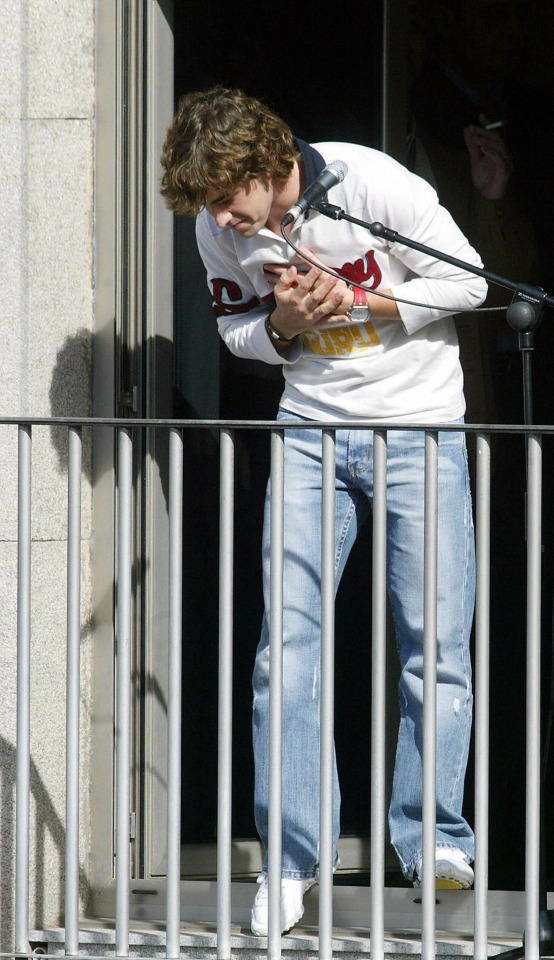

Fernando Alonso addresses supporters from a balcony in his home town of Oviedo in northern Spain, a day after receiving the Prince of Asturias Award for Sports October 22, 2005 - Oviedo, Spain, Source: RAFA RIVAS/AFP via Getty Images
345 notes
·
View notes
Text
Couch surfer in his 30s. Oscar winner in his 40s. Why the whole world wants Taika
**Notes: This is very long post!**
Good Weekend
In his 30s, he was sleeping on couches. By his 40s, he’d directed a Kiwi classic, taken a Marvel movie to billion-dollar success, and won an Oscar. Meet Taika Waititi, king of the oddball – and one of New Zealand’s most original creative exports.
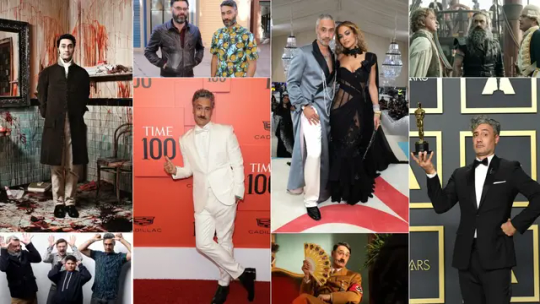
Taika Waititi: “Be a nice person and live a good life. And just don’t be an arsehole.”
The good news? Taika Waititi is still alive. I wasn’t sure. The screen we were speaking through jolted savagely a few minutes ago, with a cacophonous bang and a confused yelp, then radio silence. Now the Kiwi filmmaker is back, grinning like a loon: “I just broke the f---ing table, bro!”
Come again? “I just smashed this f---ing table and glass flew everywhere. It’s one of those old annoying colonial tables. It goes like this – see that?” Waititi says, holding up a folding furniture leg. “I hit the mechanism and it wasn’t locked. Anyway …”
I’m glad he’s fine. The stuff he’s been saying from his London hotel room could incur biblical wrath. We’re talking about his latest project, Next Goal Wins, a movie about the American Samoa soccer team’s quest to score a solitary goal, 10 years after suffering the worst loss in the game’s international history – a 31-0 ignominy to Australia – but our chat strays into spirituality, then faith, then religion.
“I don’t personally believe in a big guy sitting on a cloud judging everyone, but that’s just me,” Waititi says, deadpan. “Because I’m a grown-up.”
This is the way his interview answers often unfold. Waititi addresses your topic – dogma turns good people bad, he says, yet belief itself is worth lauding – but bookends every response with a conspiratorial nudge, wink, joke or poke. “Regardless of whether it’s some guy living on a cloud, or some other deity that you’ve made up – and they’re all made up – the message across the board is the same, and it’s important: Be a nice person, and live a good life. And just don’t be an arsehole!”
Not being an arsehole seems to have served Waititi, 48, well. Once a national treasure and indie darling (through the quirky tenderness of his breakout New Zealand films Boy in 2010 and Hunt for the Wilderpeople in 2016), Waititi then became a star of both the global box office (through his 2017 entry into the Marvel Universe, Thor: Ragnarok, which grossed more than $1.3 billion worldwide) and then the Academy Awards (winning the 2020 best adapted screenplay Oscar for his subversive Holocaust dramedy JoJo Rabbit, in which he played an imaginary Hitler).

Waititi playing Adolf Hitler in the 2019 movie JoJo Rabbit. (Alamy)
A handsome devil with undeniable roguish charm, Waititi also slid seamlessly into style-icon status (attending this year’s Met Gala shirtless, in a floor-length gunmetal-grey Atelier Prabal Gurung wrap coat, with pendulous pearl necklaces), as well as becoming his own brand (releasing an eponymous line of canned coffee drinks) and bona fide Hollywood A-lister (he was introduced to his second wife, British singer Rita Ora, by actor Robert Pattinson at a barbecue).
Putting that platform to use, Waititi is an Indigenous pioneer and mentor, too, co-creating the critically acclaimed TV series Reservation Dogs, while co-founding the Piki Films production company, committed to promoting the next generation of storytellers – a mission that might sound all weighty and worthy, yet Waititi’s new wave of First Nations work is never earnest, always mixing hurt with heart and howling humour.

Waititi with wife Rita Ora at the 2023 Met Gala in May. (Getty Images)
Makes sense. Waititi is a byproduct of “the weirdest coupling ever” – his late Maori father from the Te Whanau-a-Apanui tribe was an artist, farmer and “Satan’s Slaves” bikie gang founder, while his Wellington schoolteacher mum descended from Russian Jews, although he’s not devout about her faith. (“No, I don’t practise,” he confirms. “I’m just good at everything, straight away.”)
He’s remained loyally tethered to his origin story, too – and to a cadre of creative Kiwi mates, including actors Jemaine Clement and Rhys Darby – never forgetting that not long before the actor/writer/producer/director was an industry maven, he was a penniless painter/photographer/ musician/comedian.
With no set title and no fixed address, he’s seemingly happy to be everything, everywhere (to everyone) all at once. “‘The universe’ is bandied around a lot these days, but I do believe in the kind of connective tissue of the universe, and the energy that – scientifically – we are made up of a bunch of atoms that are bouncing around off each other, and some of the atoms are just squished together a bit tighter than others,” he says, smiling. “We’re all made of the same stardust, and that’s pretty special.”
-----------------------------------------------
We’ve caught Waititi in a somewhat relaxed moment, right before the screen actors’ and media artists’ strike ends. He’s sensitive to the struggle but doesn’t deny enjoying the break. “I spent a lot of time thinking about writing, and not writing, and having a nice holiday,” he tells Good Weekend. “Honestly, it was a good chance just to recombobulate.”
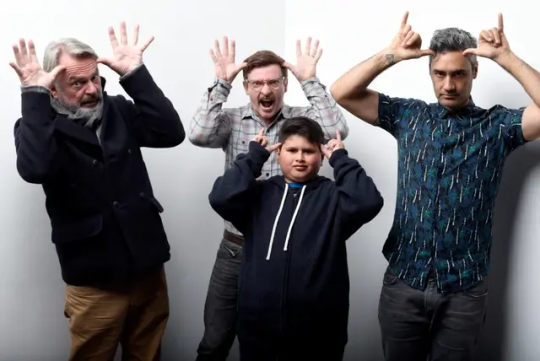
Waititi, at right, with Hunt for the Wilderpeople actors, from left, Sam Neill, Rhys Darby and Julian Dennison. (Getty Images)
It’s mid-October, and he’s just headed to Paris to watch his beloved All Blacks in the Rugby World Cup. He’s deeply obsessed with the game, and sport in general. “Humans spend all of our time knowing what’s going to happen with our day. There’s no surprises any more. We’ve become quite stagnant. And I think that’s why people love sport, because of the air of unpredictability,” he says. “It’s the last great arena entertainment.”
The main filmic touchstone for Next Goal Wins (which premieres in Australian cinemas on New Year’s Day) would be Cool Runnings (1993), the unlikely true story of a Jamaican bobsled team, but Waititi also draws from genre classics such as Any Given Sunday and Rocky, sampling trusted tropes like the musical training montage. (His best one is set to Everybody Wants to Rule the World by Tears for Fears.)
Filming in Hawaii was an uplifting experience for the self-described Polynesian Jew. “It wasn’t about death, or people being cruel to each other. Thematically, it was this simple idea, of getting a small win, and winning the game wasn’t even their goal – their goal was to get a goal,” he says. “It was a really sweet backbone.”
Waititi understands this because, growing up, he was as much an athlete as a nerd, fooling around with softball and soccer before discovering rugby league, then union. “There’s something about doing exercise when you don’t know you’re doing exercise,” he enthuses. “It’s all about the fun of throwing a ball around and trying to achieve something together.” (Whenever Waititi is in Auckland he joins his mates in a long-running weekend game of touch rugby. “And then throughout the week I work out every day. Obviously. I mean, look at me.”)
Auckland is where his kids live, too, so he spends as much time there as possible. Waititi met his first wife, producer Chelsea Winstanley, on the set of Boy in 2010, and they had two daughters, Matewa Kiritapu, 8, and his firstborn, Te Kainga O’Te Hinekahu, 11. (The latter is a derivative of his grandmother’s name, but he jokes with American friends that it means “Resurrection of Tupac” or “Mazda RX7″) Waititi and Winstanley split in about 2018, and he married the pop star Ora in 2022.
He offers a novel method for balancing work with parenthood … “Look, you just abandon them, and know that the experience will make them harder individuals later on in life. And it’s their problem,” he says. “I’m going to give them all of the things that they need, and I’m going to leave behind a decent bank account for their therapy, and they will be just like me, and the cycle will continue.”
Jokes aside – I think he’s joking – school holidays are always his, and he brings the girls onto the set of every movie he makes. “They know enough not to get in the way or touch anything that looks like it could kill you, and they know to be respectful and quiet when they need to. But they’re just very comfortable around filmmakers, which I’m really happy about, because eventually I hope they will get into the industry. One more year,” he laughs, “then they can leave school and come work for Dad.”
Theirs is certainly a different childhood than his. Growing up, he was a product of two worlds. His given names, for instance, were based on his appearance at birth: “Taika David” if he looked Maori (after his Maori grandfather) and “David Taika” if he looked Pakeha (after his white grandfather). His parents split when he was five, so he bounced between his dad’s place in Waihau Bay, where he went by the surname Waititi, and his mum, eight hours drive away in Wellington, where he went by Cohen (the last name on his birth certificate and passport).
Waititi was precocious, even charismatic. His mother Robin once told Radio New Zealand that people always wanted to know him, even as an infant: “I’d be on a bus with him, and he was that kind of baby who smiled at people, and next thing you know they’re saying, ‘Can I hold your baby?’ He’s always been a charmer to the public eye.”
He describes himself as a cool, sporty, good-looking nerd, raised on whatever pop culture screened on the two TV channels New Zealand offered in the early 1980s, from M*A*S*H and Taxi to Eddie Murphy and Michael Jackson. He was well-read, too. When punished by his mum, he would likely be forced to analyse a set of William Blake poems.
He puts on a whimpering voice to describe their finances – “We didn’t have much monneeey” – explaining how his mum spent her days in the classroom but also worked in pubs, where he would sit sipping a raspberry lemonade, doodling drawings and writing stories. She took in ironing and cleaned houses; he would help out, learning valuable lessons he imparts to his kids. “And to random people who come to my house,” he says. “I’ll say, ‘Here’s a novel idea, wash this dish,’ but people don’t know how to do anything these days.”
“Every single character I’ve ever written has been based on someone I’ve known or met or a story I’ve stolen from someone.” - Taika Waititi
He loved entertaining others, clearly, but also himself, recording little improvised radio plays on a tape deck – his own offbeat versions of ET and Indiana Jones and Star Wars. “Great free stuff where you don’t have any idea what the story is as you’re doing it,” he says. “You’re just sort of making it up and enjoying the freedom of playing god in this world where you can make people and characters do whatever you want.”
His other sphere of influence lay in Raukokore, the tiny town where his father lived. Although Boy is not autobiographical, it’s deeply personal insofar as it’s filmed in the house where he grew up, and where he lived a life similar to that portrayed in the story, surrounded by his recurring archetypes: warm grandmothers and worldly kids; staunch, stoic mums; and silly, stunted men. “Every single character I’ve ever written has been based on someone I’ve known or met,” he says, “or a story I’ve stolen from someone.”
He grew to love drawing and painting, obsessed early on with reproducing the Sistine Chapel. During a 2011 TED Talk on creativity, Waititi describes his odd subject matter, from swastikas and fawns to a picture of an old lady going for a walk … upon a sword … with Robocop. “My father was an outsider artist, even though he wouldn’t know what that meant,” Waititi told the audience in Doha. “I love the naive. I love people who can see things through an innocent viewpoint. It’s inspiring.”

After winning Best Adapted Screenplay Academy Award for JoJo Rabbit in 2020. (Getty Images)
It was an interesting time in New Zealand, too – a coming-of-age decade in which the Maori were rediscovering their culture. His area was poor, “but only financially,” he says. “It’s very rich in terms of the people and the culture.” He learned kapa haka – the songs, dances and chants performed by competing tribes at cultural events, or to honour people at funerals and graduations – weddings, parties, anything. “Man, any excuse,” he explains. “A big part of doing them is to uplift your spirits.”
Photography was a passion, so I ask what he shot. “Just my penis. I sent them to people, but we didn’t have phones, so I would print them out, post them. One of the first dick pics,” he says. Actually, his lens was trained on regular people. He watches us still – in airports, restaurants. “Other times late at night, from a tree. Whatever it takes to get the story. You know that.”
He went to the Wellington state school Onslow College and did plays like Androcles and the Lion, A Midsummer Night’s Dream and The Crucible. His crew of arty students eventually ended up on stage at Bats Theatre in the city, where they would perform haphazard comedy shows for years.
“Taika was always rebellious and wild in his comedy, which I loved,” says his high school mate Jackie van Beek, who became a longtime collaborator, including working with Waititi on a Tourism New Zealand campaign this year. “I remember he went through a phase of turning up in bars around town wearing wigs, and you’d try and sit down and have a drink with him but he’d be doing some weird character that would invariably turn up in some show down the track.”
He met more like-minded peers at Victoria University, including Jemaine Clement (who’d later become co-creator of Flight of the Conchords). During a 2019 chat with actor Elijah Wood, Waititi describes he and Clement clocking one another from opposite sides of the library one day: a pair of Maoris experiencing hate at first sight, based on a mutual suspicion of cultural appropriation. (Clement was wearing a traditional tapa cloth Samoan shirt, and Waititi was like: “This motherf---er’s not Samoan.” Meanwhile, Waititi was wearing a Rastafarian beanie, and Clement was like, “This motherf---er’s not Jamaican.”)

With Jemaine Clement in 2014. (Getty Images)
But they eventually bonded over Blackadder and Fawlty Towers, and especially Kenny Everett, and did comedy shows together everywhere from Edinburgh to Melbourne. Waititi was almost itinerant, spending months at a time busking, or living in a commune in Berlin. He acted in a few small films, and then – while playing a stripper on a bad TV show – realised he wanted to try life behind the camera. “I became tired of being told what to do and ordered around,” he told Wellington’s Dominion Post in 2004. “I remember sitting around in the green room in my G-string thinking, ‘Why am I doing this? Just helping someone else to realise their dream.’ ”
He did two strong short films, then directed his first feature – Eagle vs Shark (2007) – when he was 32. He brought his mates along (Clement, starring with Waititi’s then-girlfriend Loren Horsley), setting something of a pattern in his career: hiring friends instead of constantly navigating new working relationships. “If you look at things I’m doing,” he tells me, “there’s always a few common denominators.”
Sam Neill says Waititi is the exemplar of a new New Zealand humour. “The basis of it is this: we’re just a little bit crap at things.”
This gang of collaborators shares a common Kiwi vibe, too, which his longtime friend, actor Rhys Darby, once coined “the comedy of the mundane”. Their new TV show, Our Flag Means Death, for example, leans heavily into the mundanity of pirate life – what happens on those long days at sea when the crew aren’t unsheathing swords from scabbards or burying treasure.
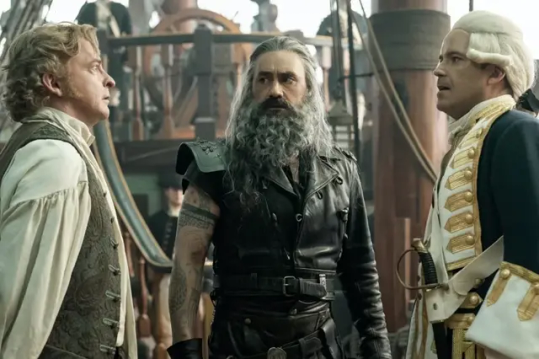
Waititi plays pirate captain Blackbeard, centre, in Our Flag Means Death, with Rhys Darby, left, and Rory Kinnear. (Google Images)
Sam Neill, who first met Waititi when starring in Hunt for the Wilderpeople, says Waititi is the exemplar of a new New Zealand humour. “And I think the basis of it is this,” says Neill. “We’re just a little bit crap at things, and that in itself is funny.” After all, Neill asks, what is What We Do in The Shadows (2014) if not a film (then later a TV show) about a bunch of vampires who are pretty crap at being vampires, living in a pretty crappy house, not quite getting busted by crappy local cops? “New Zealand often gets named as the least corrupt country in the world, and I think it’s just that we would be pretty crap at being corrupt,” Neill says. “We don’t have the capacity for it.”
Waititi’s whimsy also spurns the dominant on-screen oeuvre of his homeland – the so-called “cinema of unease” exemplified by the brutality of Once Were Warriors (1994) and the emotional peril of The Piano (1993). Waititi still explores pathos and pain, but through laughter and weirdness. “Taika feels to me like an antidote to that dark aspect, and a gift somehow,” Neill says. “And I’m grateful for that.”
-----------------------------------------------
Something happened to Taika Waititi when he was about 11 – something he doesn’t go into with Good Weekend, but which he considered a betrayal by the adults in his life. He mentioned it only recently – not the moment itself, but the lesson he learnt: “That you cannot and must not rely on grown-ups to help you – you’re basically in the world alone, and you’re gonna die alone, and you’ve just gotta make it all for yourself,” he told Irish podcast host James Brown. “I basically never forgave people in positions of responsibility.”
What does that mean in his work? First, his finest films tend to reflect the clarity of mind possessed by children, and the unseen worlds they create – fantasies conjured up as a way to understand or overcome. (His mum once summed up the main message of Boy: “The unconditional love you get from your children, and how many of us waste that, and don’t know what we’ve got.”)
Second, he’s suited to movie-making – “Russian roulette with art” – because he’s drawn to disruptive force and chaos. And that in turn produces creative defiance: allowing him to reinvigorate the Marvel Universe by making superheroes fallible, or tell a Holocaust story by making fun of Hitler. “Whenever I have to deal with someone who’s a boss, or in charge, I challenge them,” he told Brown, “and I really do take whatever they say with a pinch of salt.”
It’s no surprise then that Waititi was comfortable leaping from independent films to the vast complexity of Hollywood blockbusters. He loves the challenge of coordinating a thousand interlocking parts, requiring an army of experts in vocations as diverse as construction, sound, art, performance and logistics. “I delegate a lot,” he says, “and share the load with a lot of people.”
“This is a cool concept, being able to afford whatever I want, as opposed to sleeping on couches until I was 35.” - Taika Waititi
But the buck stops with him. Time magazine named Waititi one of its Most Influential 100 People of 2022. “You can tell that a film was made by Taika Waititi the same way you can tell a piece was painted by Picasso,” wrote Sacha Baron Cohen. Compassionate but comic. Satirical but watchable. Rockstar but auteur. “Actually, sorry, but this guy’s really starting to piss me off,” Cohen concluded. “Can someone else write this piece?”
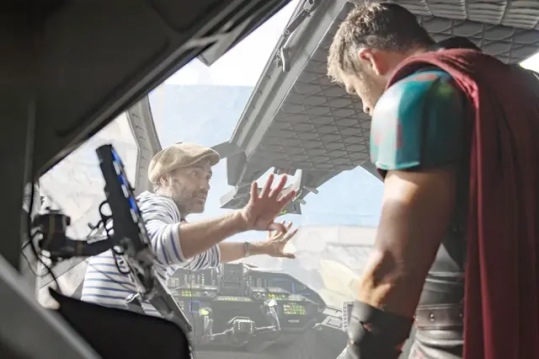
Directing Chris Hemsworth in 2017 in Thor: Ragnarok, which grossed more than $1.3 billion at the box office. (Alamy)
I’m curious to know how he stays grounded amid such adulation. Coming into the game late, he says, helped immensely. After all, Waititi was 40 by the time he left New Zealand to do Thor: Ragnarok. “If you let things go to your head, then it means you’ve struggled to find out who you are,” he says. “But I’ve always felt very comfortable with who I am.” Hollywood access and acclaim – and the pay cheques – don’t erase memories of poverty, either. “It’s more like, ‘Oh, this is a cool concept, being able to afford whatever I want, as opposed to sleeping on couches until I was 35.’ ” Small towns and strong tribes keep him in check, too. “You know you can’t piss around and be a fool, because you’re going to embarrass your family,” he says. “Hasn’t stopped me, though.”
Sam Neill says there was never any doubt Waititi would be able to steer a major movie with energy and imagination. “It’s no accident that the whole world wants Taika,” he says. “But his seductiveness comes with its own dangers. You can spread yourself a bit thin. The temptation will be to do more, more, more. That’ll be interesting to watch.”
Indeed, I find myself vicariously stressed out over the list of potential projects in Waititi’s future. A Roald Dahl animated series for Netflix. An Apple TV show based on the 1981 film Time Bandits. A sequel to What We Do In The Shadows. A reboot of Flash Gordon. A gonzo horror comedy, The Auteur, starring Jude Law. Adapting a cult graphic novel, The Incal, as a feature. A streaming series based on the novel Interior Chinatown. A film based on a Kazuo Ishiguro bestseller. Plus bringing to life the wildly popular Akira comic books. Oh, and for good measure, a new instalment of Star Wars, which he’s already warned the world will be … different.
“It’s going to change things,” he told Good Morning America. “It’s going to change what you guys know and expect.”
Did I say I was stressed for Waititi? I meant physically sick.
“Well…” he qualifies, “some of those things I’m just producing, so I come up with an idea or someone comes to me with an idea, and I shape how ‘it’s this kind of show’ and ‘here’s how we can get it made.’ It’s easier for me to have a part in those things and feel like I’ve had a meaningful role in the creative process, but also not having to do what I’ve always done, which is trying to control everything.”

In the 2014 mockumentary horror film What We Do in the Shadows, which he co-directed with Jemaine Clement. (Alamy)
What about moving away from the niche New Zealand settings he represented so well in his early work? How does he stay connected to his roots? “I think you just need to know where you’re from,” he says, “and just don’t forget that.”
They certainly haven’t forgotten him.
Jasmin McSweeney sits in her office at the New Zealand Film Commission in Wellington, surrounded by promotional posters Waititi signed for her two decades ago, when she was tasked with promoting his nascent talent. Now the organisation’s marketing chief, she talks to me after visiting the heart of thriving “Wellywood”, overseeing the traditional karakia prayer on the set of a new movie starring Geoffrey Rush.
Waititi isn’t the first great Kiwi filmmaker – dual Oscar-winner Jane Campion and blockbuster king Peter Jackson come to mind – yet his particular ascendance, she says, has spurred unparalleled enthusiasm. “Taika gave everyone here confidence. He always says, ‘Don’t sit around waiting for people to say, you can do this.’ Just do it, because he just did it. That’s the Taika effect.”
-----------------------------------------------
Taika David Waititi is known for wearing everything from technicolour dreamcoats to pineapple print rompers, and today he’s wearing a roomy teal and white Isabel Marant jumper. The mohair garment has the same wispy frizz as his hair, which curls like a wave of grey steel wool, and connects with a shorn salty beard.
A stylish silver fox, it wouldn’t surprise anyone if he suddenly announced he was launching a fashion label. He’s definitely a commercial animal, to the point of directing television commercials for Coke and Amazon, along with a fabulous 2023 spot for Belvedere vodka starring Daniel Craig. He also joined forces with a beverage company in Finland (where “taika” means “magic”) to release his coffee drinks. Announcing the partnership on social media, he flagged that he would be doing more of this kind of stuff, too (“Soz not soz”).
Waititi has long been sick of reverent portrayals of Indigenous people talking to spirits.
There’s substance behind the swank. Fashion is a creative outlet but he’s also bought sewing machines in the past with the intention of designing and making clothes, and comes from a family of tailors. “I learnt how to sew a button on when I was very young,” he says. “I learnt how to fix holes or patches in your clothes, and darn things.”
And while he gallivants around the globe watching Wimbledon or modelling for Hermès at New York Fashion Week, all that glamour belies a depth of purpose, particularly when it comes to Indigenous representation.
There’s a moment in his new movie where a Samoan player realises that their Dutch coach, played by Michael Fassbender, is emotionally struggling, and he offers a lament for white people: “They need us.” I can’t help but think Waititi meant something more by that line – maybe that First Nations people have wisdom to offer if others will just listen?
“Weeelllll, a little bit …” he says – but from his intonation, and what he says next, I’m dead wrong. Waititi has long been sick of reverent portrayals of Indigenous people talking to kehua (spirits), or riding a ghost waka (phantom canoe), or playing a flute on a mountain. “Always the boring characters,” he says. “They’ve got no real contemporary relationship with the world, because they’re always living in the past in their spiritual ways.”

A scene from Next Goal Wins, filmed earlier this year. (Alamy)
He’s part of a vanguard consciously poking fun at those stereotypes. Another is the Navajo writer and director Billy Luther, who met Waititi at Sundance Film Festival back in 2003, along with Reservation Dogs co-creator Sterlin Harjo. “We were this group of outsiders trying to make films, when nobody was really biting,” says Luther. “It was a different time. The really cool thing about it now is we’re all working. We persevered. We didn’t give up. We slept on each other’s couches and hung out. It’s like family.”
Waititi has power now, and is known for using Indigenous interns wherever possible (“because there weren’t those opportunities when I was growing up”), making important introductions, offering feedback on scripts, and lending his name to projects through executive producer credits, too, which he did for Luther’s new feature film, Frybread Face and Me (2023).
He called Luther back from the set of Thor: Love and Thunder (2022) to offer advice on working with child actors – “Don’t box them into the characters you’ve created,” he said, “let them naturally figure it out on their own” – but it’s definitely harder to get Waititi on the phone these days. “He’s a little bitch,” Luther says, laughing. “Nah, there’s nothing like him. He’s a genius. You just knew he was going to be something. I just knew it. He’s my brother.“
I’ve been asked to explicitly avoid political questions in this interview, probably because Waititi tends to back so many causes, from child poverty and teenage suicide to a campaign protesting offshore gas and oil exploration near his tribal lands. But it’s hard to ignore his recent Instagram post, sharing a viral video about the Voice to Parliament referendum starring Indigenous Aussie rapper Adam Briggs. After all, we speak only two days after the proposal is defeated. “Yeah, sad to say but, Australia, you really shat the bed on that one,” Waititi says, pausing. “But go see my movie!”
About that movie – the early reviews aren’t great. IndieWire called it a misfire, too wrapped in its quirks to develop its arcs, with Waititi’s directorial voice drowning out his characters, while The Guardian called it “a shoddily made and strikingly unfunny attempt to tell an interesting story in an uninteresting way”. I want to know how he moves past that kind of criticism. “For a start, I never read reviews,” he says, concerned only with the opinion of people who paid for admission, never professional appraisals. “It’s not important to me. I know I’m good at what I do.”
Criticism that Indigenous concepts weren’t sufficiently explained in Next Goal Wins gets his back up a little, though. The film’s protagonist, Jaiyah Saelua, the first transgender football player in a FIFA World Cup qualifying match, is fa’afafine – an American Samoan identifier for someone with fluid genders – but there wasn’t much exposition of this concept in the film. “That’s not my job,” Waititi says. “It’s not a movie where I have to explain every facet of Samoan culture to an audience. Our job is to retain our culture, and present a story that’s inherently Polynesian, and if you don’t like it, you can go and watch any number of those other movies out there, 99 per cent of which are terrible.”
*notes: (there is video clip in the article)
Waititi sounds momentarily cranky, but he’s mostly unflappable and hilarious. He’s the kind of guy who prefers “Correctumundo bro!” to “Yes”. When our video connection is too laggy, he plays up to it by periodically pretending to be frozen, sitting perfectly still, mouth open, his big shifting eyeballs the only giveaway.
He’s at his best on set. Saelua sat next to him in Honolulu while filming the joyous soccer sequences. “He’s so chill. He just let the actors do their thing, giving them creative freedom, barely interjecting unless it was something important. His style matches the vibe of the Pacific people. We’re a very funny people. We like to laugh. He just fit perfectly.”
People do seem to love working alongside him, citing his ability to make productions fresh and unpredictable and funny. Chris Hemsworth once said that Waititi’s favourite gag is to “forget” that his microphone is switched on, so he can go on a pantomime rant for all to hear – usually about his disastrous Australian lead actor – only to “remember” that he’s wired and the whole crew is listening.
“I wouldn’t know about that, because I don’t listen to what other people say about anything – I’ve told you this,” Waititi says. “I just try to have fun when there’s time to have fun. And when you do that, and you bring people together, they’re more willing to go the extra mile for you, and they’re more willing to believe in the thing that you’re trying to do.”
Yes, he plays music between takes, and dances out of his director’s chair, but it’s really all about relaxing amid the immense pressure and intense privilege of making movies. “Do you know how hard it is just to get anything financed or green-lit, then getting a crew, getting producers to put all the pieces together, and then making it to set?” Waititi asks. “It’s a real gift, even to be working, and I feel like I have to remind people of that: enjoy this moment.”
Source: The Age
By: Konrad Marshall (December 1, 2023)
198 notes
·
View notes
Text


The most powerful moment of the coronation of King Charles III was not the gold glittering off carriages or epaulettes — not the pomp and show and signifiers of power.
It was precisely their opposite: when Charles shed his gold robes and stood in a thin white shirt, his frail humanity implied.
Then a screen was erected around him and, shielded, he had a private consultation with the Archbishop of Canterbury, who dabbed anointing oil with his hands on Charles’s bare breast.
"This was the most solemn and personal of moments,” Buckingham Palace said.
Charles was bare before God, in privacy, God being one of the last beings with no need to sign a non-disclosure agreement.


The Princess of Wales looked on as the screen shielded her father-in-law.
By contrast, she was at that point the most magnificent she had ever been, swathed in layer upon layer of regality, the dress, the robes, the hanging chains, headpiece and ribbons all serving to move the viewing gaze — subjects in every sense — from our awareness of Catherine Middleton with her everyday human DNA and towards the shared fiction of her transcendent queenliness.
Less than a year later, this moment is remembered with new and terrible power.
It is spring again, but it’s a time of hard Lenten moral reflection for us as a nation, in relationship to our royals, as well as an ever more voraciously unprivate modern celebrity culture.
Both the King and the princess have cancer, the latter’s disclosed by Catherine in an unprecedented video address on Friday, March 22.
Catherine’s speech was something of a plea bargain in which she traded not only her customary silence but her most personal of health ordeals in order to put an end to toxic rumours swirling online that had become in tone like an unruly mob rattling at the palace gates.
Or rattling at the figurative locks on her medical notes, with three workers at the London Clinic, where she and the King were treated, suspended and under investigation for allegedly trying to access her records (hers, it is important to note, the King’s were unmolested).

📷: Getty Images
What was so powerful about the anointing of the King was the sacredness of that space in which he could be fully human away from observation and judgment.
There should be another one-on-one consultation that is sacred, where anyone, from King to princess to pauper, can expect to be shriven in total privacy, and that is the sanctity of the medical room.
It used to be that priests were our only bound confidants, we could trust them to be privy to all our spiritual ills.
Now doctors are our secular priests: bound by law and ethics to enshrine confidentiality at the heart of the patient relationship.
As a result, our medical privacy in an age of oversharing and online surveillance feels both stranger and more necessary.
If we knew our every GP-inspected rash was to be posted on TikTok for the nation, many of us would quite literally die of embarrassment.
The King’s appointment behind the three-sided screen can now be viewed through the lens of royal illness.
The lavishly embroidered panels and expensive white shirt now replaced by the flimsy three-sided ward screen on wheels and thin hospital gown that can humble us all.
But it also enacts a principle at the very heart of becoming the monarch.
The medical-like screen is erected in the coronation to tell us there are some places the public cannot go; to tell us that there are sacredly personal moments in which a person, any person, however swathed in our projections of power, needs to be nakedly human.
Otherwise, they will go mad. We need to make sure the screens are erected around Catherine now.

Much is said, quite a lot of it by Prince Harry himself, of the dangers of the wives of the princes repeating the tragic history of their mother, Princess Diana, hunted by photographers.
He remains phobic to any hint of tabloid persecution or paparazzi chase. But this is a sideshow, even an anachronism in 2024.
He and others have not recognised how the “chase” has changed. Who needs paparazzi when there are a billion citizen hacks ready to take pictures with their phones, in case a convalescing woman nips to a Windsor farm shop with her husband?
Instead, the appetite now is not to see but to know.
The royals used to have a contract with the public: we pay for them, and in return, they give us their presence.
Nearly all of their official job is to do with surface: to show up, to put in appearances at a set number of functions, whether at the opening of parliament or the opening of a leisure centre.
But now parts of the online mob seem to be staging a coup. We want more than the surface, we want to puncture the skin barrier of the royal family and occupy from the inside.
The “fans” have become an invasive virus. The royal analogy is often that they are trapped in a gilded zoo. This new model, instead, casts the royals more as lab rats.

When Catherine disappeared from view in January after announcing a “planned abdominal operation,” the response from internet truthers was one of irate entitlement.
They are now the 1980s tabloids: ravening for intimacies and making stuff up when thwarted.
This wasn’t the boomer generation, who are both more respectful of the royals and more private about their own health.
It was the fortysomething mothers frustrated when they can’t track the phone location of everyone in their life; or the twentysomethings on Snap Map.
Both desperate for their personalised new Netflix season of “The Royals” to drop.
Catherine presents with such stoicism and dignity, it is easy to forget where this new invasiveness started: when she was pregnant with Prince George in December 2012 and hospitalised for extreme morning sickness.
While she was sleeping on the ward, a radio station in Australia rang the hospital switchboard pretending to be the Queen.
They broadcast the nurse’s comments about Catherine’s “retching.”
One could only find this prank funny if Catherine had already — a young, wretchedly ill, pregnant woman — been dehumanised.
George is now ten and his mother hospitalised again, and in that decade, the physical security of ill royals may have tightened but their claim to bodily autonomy seems to have weakened.

Some say Kensington Palace “brought it on themselves” by their wish for discretion; this claim is duplicitous.
The late Queen Elizabeth II became increasingly debilitated in her final years with not much detail ever given; just as her father, King George VI, died without disclosing his lung cancer.
I’m glad that the British do not subject their heads of state to the same publicised medical reports as the president of the United States; one shouldn’t have to present a stool swab to sit on the throne.
No, instead the apparent justification of all those clicking and posting conspiracy theories “worried for Catherine’s welfare” was this sinful truth.
As a beautiful, 42-year-old mother of three, her drama was more box office than the ailments of those older, a pound of her flesh was worth more.
Pity, Susan Sontag said in her 1978 book Illness as Metaphor, is close to contempt.
Back then cancer was still taboo. Those around the patient, Sontag says, “express pity but also convey contempt.”
Ask any cancer patient and they will say they don’t want pity: it is too isolating, it sets them apart, an unwanted privilege.
This is why the video plea of Catherine was one of affinity, rather than pity or privilege.
Last year, she sat in robes in Westminster Abbey at the coronation of her father-in-law, next to her future king son and future king husband.
In her video address last week, she sat on a classically English garden bench, pale, alone and in jeans, as bare of pomp as any royal can be.
No mention of kings or titles, just Diana’s ring on her hand.
Rather she gave an appeal, parent to parent, human to human, about her “huge shock” and her care for her “young family.”
And, finally, her kinship with anyone who lives in a vulnerable human body susceptible to a democratic illness like cancer, “you are not alone.”
Or, to paraphrase Richard Curtis:
“I’m just a girl, standing in front of a public, asking for some time to endure gruelling chemotherapy."

NOTE: Additional photos have been included in this article.
#King Charles III#Prince William#Prince of Wales#Princess of Wales#Catherine Princess of Wales#Catherine Middleton#Kate Middleton#British Royal Family#cancer#chemotherapy#preventative chemotherapy#social media#fake news#click farms#bots#trolls#disinformation#misinformation#viral#abdominal surgery#celebrity culture
80 notes
·
View notes
Text
They're takin' shots, I'm takin' spots, I see the shade, then they get blocked, they see the chain, then they went blind. how do you hate me if I'm on your mind? sending me messages and valentines, bitches is messy but I'm petty. dont gotta edit, check the getty. I keep it real, I keep it sexy. calling for backup before they address me. hoes do all of that typin', but never once did I get pressed. It's obvious bitches obsessed. if it's fuck me then we havin' sex


#you are taking spots yes you are ma’am#boa kinda heat ngl#megan thee stallion#lanesus music recs for the uncultured
68 notes
·
View notes
Text

Elon Musk is seen on a large screen as Alice Weidel, co-leader of Germany's far-right Alternative for Germany (AfD) party, addresses an election campaign rally in Halle, Germany, Jan. 25, 2025. (AFP via Getty Images)
19 notes
·
View notes
Text
🎨🇵🇸 #ArtIsAWeapon

Reposted from @hyperallergic Every May 15 for the last 76 years, Palestinians around the world commemorate the #Nakba (Arabic for "the catastrophe”), during which 750,000 Palestinians were permanently displaced from their homelands as a result of the establishment of the State of Isr@el. During this mass exodus, the ancient embroidery practice known as taṭrīz or tatreez became an invaluable way for Palestinians to preserve their history and culture.

In the last seven months, amid Israel’s relentless attacks on G@za, many have engaged in and revived the shared practice. In November, artist Maya Amer used the embroidery as a way to visualize the more than 8,000 Palestinians who had been killed by Israeli airstrikes at that time. Others led the collaborative project Tatriz for Palestine to honor the civilians killed by the Israeli military in G@za. Today, the death toll in the G@za Strip has risen to more than 34,904.

Zain Masri was first introduced to the practice as a child while visiting her grandmother in Jordan. Decades later, when she reconnected with the art form during the pandemic, she quickly realized that there was an urgent need for accessible, high-resolution, and simple taṭrīz patterns in the international embroidery community and Palestinian diaspora.



To address this issue, Masri launched the Tirazain Initiative — a free online searchable library available in English and Arabic containing digitized patterns for more than one thousand taṭrīz motifs.
Masri told Hyperallergic that she hoped the digital library would help provide “a platform for Palestinian women to share their work and to connect with other taṭrīz enthusiasts,” as well as promote the art form across cultures and communities.
Read more through the link in bio
🔗https://hyperallergic.com/915145/preserving-the-art-of-palestinian-tatriz-76-years-after-the-nakba/https://hyperallergic.com/915145/preserving-the-art-of-palestinian-tatriz-76-years-after-the-nakba/
.
.
.
1-3, 5, 6 - Images via Tirazain Initiative, courtesy Zain Masri
4 - Photo by Philippe Lissac/Getty Images
#Embroidery #Tatriz #Tatreez
#Palestine#PalestinianArt#PalestinianCulture#CeasefireNow#Tirazain Initiative#Zain Masri#Tatriz#Tatreez
37 notes
·
View notes
Text
Travis Gettys at Raw Story:
Donald Trump has considered privatizing the U.S. Postal Service after decades of Republican attacks, but an analysis sent him a warning that his own supporters would hurt the most is he goes ahead with it. The president-elect has complained frequently that USPS was a "loser" and blamed nonexistent mail-in voter fraud for his 2020 election loss. Republicans have faulted the service for running a deficit despite its statutory obligation to "bind the Nation together" by providing "prompt, reliable, and efficient services to patrons in all areas," wrote MSNBC's Paul Waldman. "Many of the fiscal challenges the Postal Service faces are a result of the things it does that a profit-seeking private business would never do," Waldman wrote. "If the post office were privatized, it would probably start charging more — a lot more — for the services it now provides for a pittance." Sending a letter from Washington, D.C. to Los Angeles costs 73 cents using the post office, compared to about $50 or more for FedEx, the columnist wrote. A private postal service would probably charge different rates depending on the destination.
[...] The USPS maintains more than 30,000 post offices, including many remote facilities in sparsely populated areas, to keep with its mandate to serve all Americans no matter where they live. And 57 percent of post offices are located in rural areas serving just 16 percent of Americans – the vast majority of which cost more to operate than the amount of revenue they bring in. "If we shut down every outpost that doesn’t make a profit, thousands of rural post offices would close," Waldman wrote. "In other words, no one gets a better deal from the Postal Service than rural Americans — most of whom have voted emphatically for Trump in three straight presidential elections. "Bringing mail to rural areas is the least cost-effective part of what the USPS does. Commercial carriers such as UPS and FedEx won’t even bother delivering to many rural addresses; it just doesn’t make economic sense to drive miles and miles to deliver a single package."
Trump’s MAGA base in rural areas will the ones screwed the most with his insane proposal to privatize the USPS.
#Donald Trump#Privatization#USPS#United States Postal Service#Trump Administration#USPS Privatization
14 notes
·
View notes
Text

Home of architect Richard R. Stadelman in Hillside Heights, Las Vegas, photographed by Julius Shulman, 1953.
The architect of the Flamingo designed his family home. The address was 1245 S. 17th St. The address today is a heavily modified home at 1221 S. 17th St.
Julius Shulman photography archive © J. Paul Getty Trust. Getty Research Institute, Los Angeles (2004.R.10).
Below: "Quality Budget Houses; a treasury of 100 architect-designed houses from $5,000 to $20,000" by Katherine Morrow Ford; Thomas Hawk Creighton.


23 notes
·
View notes
Text
There's something poetic about the way Stede and Ed's journeys in S1 and S2 are cycling around each other. They're circling in towards a point where they will meet as themselves, but right now, they've both come in with so many preconceptions and illusions of who and what they are within their own worlds and each others.
Ed aspires to a better life and believes that Stede has that with his all his quirky, fun, weird little things ("you got it all figured out"). He willfully chooses to ignore why a rich man might actually find some kind of comfort and safety in the world of piracy, convinced by the end of S1 that it was all about Bonnet's playthings and that "we were just playing pirates".
He doesn't hear Stede when Stede says he "very much does know" what it feels like to be treading water, waiting to drown, because to him, Stede is something he wants to be. He doesn't see the flaws and the cracks and the trauma underlying it all.
Likewise, Stede does get to meet Ed as Ed first and foremost, but when he finds out he's Blackbeard, there is a kind of fanboy joy about just how cool and fascinating and brilliant his idol is.
Even though Ed tells him how he's struggling, the fact that Ed keeps on mentioning that it's boring is the thing that Stede latches onto. He does the treasure hunt to keep Ed from getting bored, he shows him things to spark his interest and entertain him.
They both get a storyline where they get to cross the streams and experience each other's world: Ed gets to be Jeff the Accountant in a fancy party ship and Stede becomes the Legendary Gentleman Pirate in the Republic. In both situations, it seems perfect and fun and fantastic, but the shine comes off and the issues are still there, simmering beneath, and never get addressed.
And the thing is that is makes perfect sense for both of them to squash down all the stuff that's actually bothering them. For Ed, being vulnerable is a danger, it's showing your belly to someone who may be an enemy, it's baring your throat and in a world where trust is a rare commodity, he absolutely does not trust anyone.
He says himself he only ever told one person about killing his dad and even then, it only came on the back of being triggered into a horrendous panic attack and Stede coming after him to comfort him (and hoooee, that speaks a lot for Ed going after Stede in 2x06). He's suppressed it and contained it and lets it sit there and fester, layers of scar tissue and self-loathing forming over it.
It's also why he sits with his issues on his own, talks to the people who have been around him the longest and makes his decision on his own. He is used to operating as a single entity without having to take into consideration how his actions and decisions impact on other people. He's only just learned how to take accountability for his actions like 2 days ago.
Stede, on the other hand, has told no one anything about what's going on inside his head. When we have the flashbacks with his father, we can see why: every time he expressed an opinion about his thoughts and wishes and ideas, he was shot down. By the time he was married off, he has learned to couch his negative reactions in passive statements instead of saying exactly what he's feeling.
And even when his past is brought up, like when Nigel brings up the story of the rowboat, he tries to brush it off and pretend he doesn't know what they're talking about. He prefers to bottle up the guilt, shame and inadequacy he feels and keep them locked away because he's spent a lifetime being ridiculed for his feelings and emotions and expressing them with the risk of being shot down in flames terrifies him.
He did express himself directly once in S1: his rant about drinking and being pelted by coconuts and not liking Ed when he's like this and the same day, Ed chose to leave him, so he doubles down.
We see him trying to maintain the facade that he's doing well, even in the letters he writes to Ed. Everything is about how they're getting on and that he hopes to see him, but when it all falls apart, the negative emotions are only addressed to the Wanted poster.
It's very telling that he only confides in a handful of people about how he's feeling across both seasons and they are Mary, Zheng and Anne. Mary, it comes on the back of a murder attempt. Zheng, it comes after he's told the crew got rid of Ed. And Anne it's when he and Ed are still butting emotional heads and it takes that forced hand to make him actually come out and express his real emotions to Ed for the first time in person.
There's something poignant about them both trying to find their way to this idea of the man they love, but both being so caught up in the illusion they've built around them that they go straight past them.
Ed has become what Stede was in S1: the man who dropped his entire life, his partner, his family and his world to go and follow a career he has no experience of because it feels safer than where he is right now. And Stede has become exactly what he thought he needed to be, to be worthy of Ed: a fearsome legendary pirate in all the ways he criticised Ed in 1x06.
"I don't like who you are around this guy," he says about Ed when he's in Jack's company, and Ed tells him "This is who I am. This is me" and now, Stede has become that. He's emulated that. This is who Ed said he is. Only he finds Ed, giddy and accepted and finally, finally considering himself Ed's equal, and Ed tells him "I don't know who I am" and leaves him.
They've been so caught up in their perceptions of this idea of who their partner is that they haven't actually looked beneath the the facade.
And a big part of the problem is that neither of them know who they are. They know who they're 'meant' to be according to the society around them and the people who shaped them ("nothing but a weak-handed, soft-hearted, lily-livered little rich boy" and "not those kind of people"). They know who they've been told to be.
Before they can go any further, they need to figure themselves out and what that means for them and their relationship with each other.
96 notes
·
View notes
Text

Researchers illuminate the mysteries of icy ocean worlds
New research advances understanding of the habitability of icy moons.
As NASA’s Europa Clipper embarks on its historic journey to Jupiter’s icy moon, Europa, Dr. Matt Powell-Palm, a faculty member at Texas A&M University’s J. Mike Walker ‘66 Department of Mechanical Engineering, has unveiled groundbreaking research that could transform our understanding of icy ocean worlds across the solar system. The study published in Nature Communications, co-authored with planetary scientist Dr. Baptiste Journaux of the University of Washington, introduces a novel thermodynamic concept called the “centotectic” and investigates the stability of liquids in extreme conditions - critical information for determining the habitability of icy moons like Europa. Revolutionizing the Search for Habitability The exploration of icy ocean worlds represents a new frontier in planetary science, focusing on understanding the potential for these environments to support life. Powell-Palm’s research addresses a fundamental question in this field: under what conditions can liquid water remain stable on these distant, frozen bodies? By defining and measuring the cenotectic, the absolute lowest temperature at which a liquid remains stable under varying pressures and concentrations, the team provides a critical framework for interpreting data from planetary exploration efforts. This study combines Powell-Palm’s expertise in cryobiology - specifically the low-temperature thermodynamics of water - initially focused on medical applications like organ preservation for transplantation, with Journaux’s expertise in planetary science and high-pressure water-ice systems. Together, they developed a framework that bridges disciplines to tackle one of the most fascinating challenges in planetary science. “With the launch of NASA Europa Clipper, the largest planetary exploration mission ever launched, we are entering a multi-decade era of exploration of cold and icy ocean worlds. Measurements from this and other missions will tell us how deep the ocean is and its composition,” said Journaux. “Laboratory measurements of liquid stability, and notably the lowest temperature possible (the newly-defined cenotectic), combined with mission results, will allow us to fully constrain how habitable the cold and deep oceans of our solar system are, and also what their final fate will be when the moons or planets have cooled down entirely.” A Texas A&M Legacy of Innovation in Space Research The research was conducted at Texas A&M and led by mechanical engineering graduate student Arian Zarriz. The work reflects Texas A&M’s deep expertise in water-ice systems and tradition of excellence in space research, which spans multiple disciplines. With the recent groundbreaking of the Texas A&M Space Institute, the university is poised to play an even larger role in space exploration, providing intellectual leadership for missions pushing the boundaries of human knowledge. “The study of icy worlds is a particular priority for both NASA and the European Space Agency, as evidenced by the flurry of recent and upcoming spacecraft launches,” said Powell-Palm. “We hope that Texas A&M will help to provide intellectual leadership in this space.” Looking Ahead As planetary exploration missions, such as those targeting icy moons, continue to expand our understanding of the solar system, researchers at Texas A&M and beyond prepare to analyze the wealth of data they will provide. By combining experimental studies like those conducted by Powell-Palm and Journaux with the findings from these missions, scientists aim to unlock the secrets of cold, ocean-bearing worlds and evaluate their potential to harbor life.
Image: Getty Images
8 notes
·
View notes
Text
PARIS 2024 🇫🇷 Adieu to Summer of Unforgettable Games
Paralympics - Closing Ceremony - Paris, France - September 8, 2024
Closing ceremony: Santa shines with Johnny Hallyday cover at the Stade de France. The Paralympic Games end with a closing ceremony that takes the form of a huge electro party to celebrate the athletes.

Santa opened the final ceremony of the Paris 2024 Games with Johnny Hallyday’s classic "Vivre pour le Meilleur".

Breaking takes the stage!

This modern dance with a strong power of inclusion is featured in the closing ceremony. A celebration of diversity to the beats of Cut Killer 🎉 @Thomajolly, Directeur artistique des cérémonies de Paris 2024



International Paralympic Committee President Andrew Parsons Closing Ceremony speech

Tony Estanguet, the president of Paris 2024, addresses the crowd.

The evening kicks off perfectly with Jean Michel Jarre igniting the Stade de France.

Picture by Ezra Shaw/Getty Images
The Paralympic Flame arrived at the Stade de France, the lantern as it passed from one Paralympic athlete to another until arriving in the hands of three-time Paris 2024 champion in Para-cycling road Mathieu Bosredon and France’s first Paralympic boccia champion Aurelie Aubert.
Together they blew out the flame and, as they did, the flame in the hot-air balloon cauldron suspended in the air over the Tuileries Garden
“Let's keep doing, let's keep believing and above all... let's keep daring."

The Paralympic Flame is extinguished, and the Paris 2024 Games have come to an end. (darn dust in the eye) 📸 Getty / Graham Denholm
The job is done!
Merci beaucoup! Paris 🇫🇷
Now it's your turn @LA28 🇺🇸 and make us dream in four years!
#Paralympics #Paris2024 #closingceremony #@LA28 #Paris
Posted 8th September 2024
13 notes
·
View notes